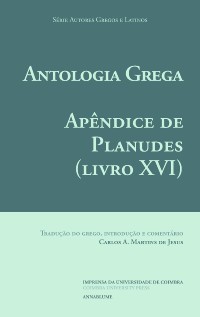Please use this identifier to cite or link to this item:
https://hdl.handle.net/10316.2/41181| DC Field | Value | Language |
|---|---|---|
| dc.contributor.author | Jesus, Carlos A. Martins de | por |
| dc.date.accessioned | 2017-03-20T14:57:28Z | |
| dc.date.accessioned | 2020-03-15T20:38:51Z | - |
| dc.date.available | 2017-03-20T14:57:28Z | |
| dc.date.available | 2020-03-15T20:38:51Z | - |
| dc.date.issued | 2017 | - |
| dc.identifier.isbn | 978-989-26-1331-4 | por |
| dc.identifier.isbn | 978-989-26-1332-1 (PDF) | por |
| dc.identifier.uri | https://hdl.handle.net/10316.2/41181 | por |
| dc.description.abstract | The Planudean, copied in the fourteenth-century autograph Marcianus gr. 481, was between the sixteenth and the eighteenth centuries the single known garland of Greek epigram, having had, therefore, a huge influence in modern poetry and culture in general. As a didactic text it was for Renaissance students of Greek and Latin, it was frequently their first contact with Greek literature. Poets and other writers made a large use of it. Erasmus is an example, he who copies and comments in his Adagia about 50 components, alongside Alciato’s Emblemmata, first published in 1492, where a much larger number of epigrams are illustrated, translated into Latin and commented. This volume offers in translation the epigrams transmitted by Planudes that are absent from the Palatinus, nowadays published as Book XVI of the Greek Antholoy. The larger part of them (356 out of 392) comes from chapter IV of the Marcianus, a collection of ecphrastic poems. Among them are the components dedicated to the charioteers of Constantinople (numbers 335-386), which archaeology proved to have been actually inscribed. | eng |
| dc.description.abstract | A Antologia de Planudes, conservada no autógrafo Marcianus gr. 481 do século XIV, foi durante os séculos XVI-XVIII a única recensão do epigrama grego conhecida e divulgada e exerceu, por isso mesmo, uma influência notável na poesia e na cultura moderna em geral. Texto pedagógico nuclear para alunos renascentistas de grego e latim, com frequência constituía o seu primeiro contato com a literatura grega. Poetas e escritores de todos os tempos dela se serviram. Erasmo, que copia e comenta nos Adagia cerca de cinquenta componentes, mas também os Emblemmata de Alciato, pela primeira vez publicados em 1492, que ilustram, traduzem para latim e comentam um muito maior número de epigramas. O presente volume oferece em tradução os epigramas transmitidos por Planudes que estão ausentes do Palatinus, nas edições modernas publicados como Livro XVI da Antologia Grega. A grande maioria destes textos (356 de um total de 392) provêm do capítulo IV do Marcianus, recolha de epigramas descritivos ou ecfrásticos. Destes, realçam os componentes dedicados aos aurigas de Constantinopla (núms. 335 | por |
| dc.language.iso | por | por |
| dc.publisher | Imprensa da Universidade de Coimbra | por |
| dc.rights | open access | por |
| dc.subject | Greek Anthology | eng |
| dc.subject | Planudean | eng |
| dc.subject | epigram | eng |
| dc.subject | Antologia Grega | por |
| dc.subject | Antologia de Planudes | por |
| dc.subject | epigrama | por |
| dc.title | Antologia Grega: apêndice de Planudes (livro XVI) | por |
| dc.title.alternative | Greek Anthology: the Planudean (book XVI) | eng |
| dc.type | book | por |
| uc.publication.location | Coimbra | por |
| dc.identifier.doi | 10.14195/978-989-26-1332-1 | por |
| uc.publication.digCollection | PB | por |
| uc.publication.area | Artes e Humanidades | por |
| uc.publication.manifest | https://dl.uc.pt/json/iiif/10316.2/41181/149664/manifest?manifest=/json/iiif/10316.2/41181/149664/manifest | - |
| uc.publication.thumbnail | https://dl.uc.pt/retrieve/8254689 | - |
| uc.itemId | 54667 | - |
| item.grantfulltext | open | - |
| item.fulltext | With Fulltext | - |
| Appears in Collections: | Pombalina | |
Files in This Item:
| File | Description | Size | Format | |
|---|---|---|---|---|
| antologia_grega_apendice_de_planudes.pdf | 1.04 MB | Adobe PDF |  |
Items in DSpace are protected by copyright, with all rights reserved, unless otherwise indicated.
